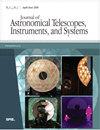Imaging quality evaluation method for large field-of-view telescope optical systems
IF 3.1
3区 工程技术
Q2 ENGINEERING, AEROSPACE
Journal of Astronomical Telescopes Instruments and Systems
Pub Date : 2024-04-01
DOI:10.1117/1.jatis.10.2.025003
引用次数: 0
Abstract
Large-field telescopes play a significant role in cutting-edge astronomical research fields, such as time-domain astronomy and cosmology. For such telescopes, ensuring symmetrical and uniform imaging across the entire field-of-view (FoV) is pivotal, particularly for areas such as astronomical photometry and astrometry. However, conventional image quality evaluation methods for telescope optical systems have mainly focused on imaging spot size. Other alternative methods, such as ellipticity based methods, also face the challenges of high computational requirements and limited assessment parameters. In addition, establishing a coherent link between the telescope structure and research domains such as photometry has remained a challenge. In response to these challenges, we introduce an assessment approach termed the ray tracing, spot-vector index, and angle (RSVA) approach. This approach offers a fresh perspective on optical systems, prioritizing the depiction of imaging spot shapes. It acts as a valuable supplement to traditional methods and has been effectively employed to analyze four 1-m aperture telescopes with an f-ratio of 3 for a 3 deg FoV. Building on this foundation, the RSVA can be further expanded to explore other research avenues, including exploring the interplay between photometry and telescope systems and guiding large FoV optical design.大视场望远镜光学系统成像质量评估方法
大视场望远镜在时域天文学和宇宙学等尖端天文研究领域发挥着重要作用。对于这类望远镜来说,确保整个视场(FoV)的对称和均匀成像至关重要,尤其是在天文测光和天体测量等领域。然而,传统的望远镜光学系统图像质量评估方法主要侧重于成像光斑的大小。其他替代方法,如基于椭圆度的方法,也面临着计算要求高和评估参数有限的挑战。此外,在望远镜结构和光度测量等研究领域之间建立连贯的联系仍然是一项挑战。为了应对这些挑战,我们引入了一种评估方法,即光线跟踪、光斑矢量指数和角度(RSVA)方法。这种方法为光学系统提供了一个全新的视角,优先考虑成像光斑形状的描述。它是对传统方法的重要补充,已被有效地用于分析四台 1 米孔径的望远镜,其 f 比为 3,视场角为 3 度。在此基础上,RSVA 可以进一步扩展,探索其他研究途径,包括探索光度测量与望远镜系统之间的相互作用,以及指导大视场光学设计。
本文章由计算机程序翻译,如有差异,请以英文原文为准。
求助全文
约1分钟内获得全文
求助全文
来源期刊

Journal of Astronomical Telescopes Instruments and Systems
Engineering-Mechanical Engineering
CiteScore
4.40
自引率
13.00%
发文量
119
期刊介绍:
The Journal of Astronomical Telescopes, Instruments, and Systems publishes peer-reviewed papers reporting on original research in the development, testing, and application of telescopes, instrumentation, techniques, and systems for ground- and space-based astronomy.
 求助内容:
求助内容: 应助结果提醒方式:
应助结果提醒方式:


